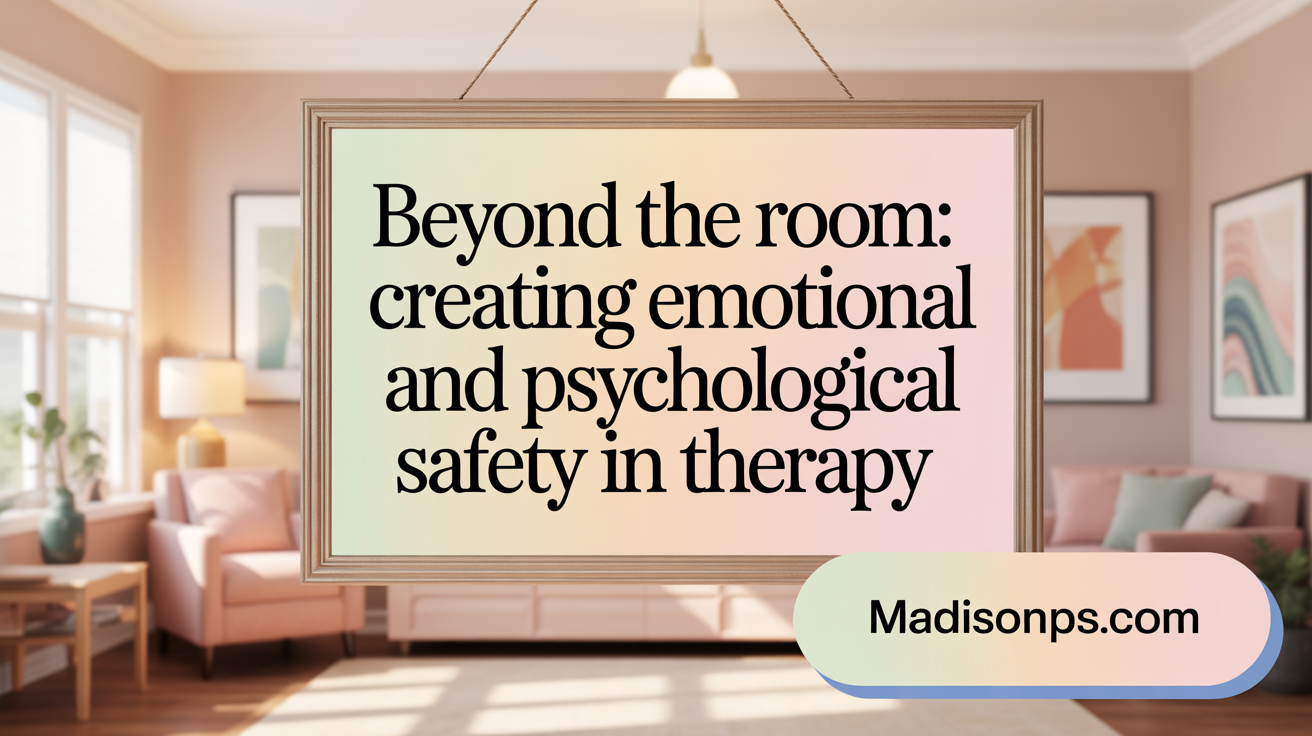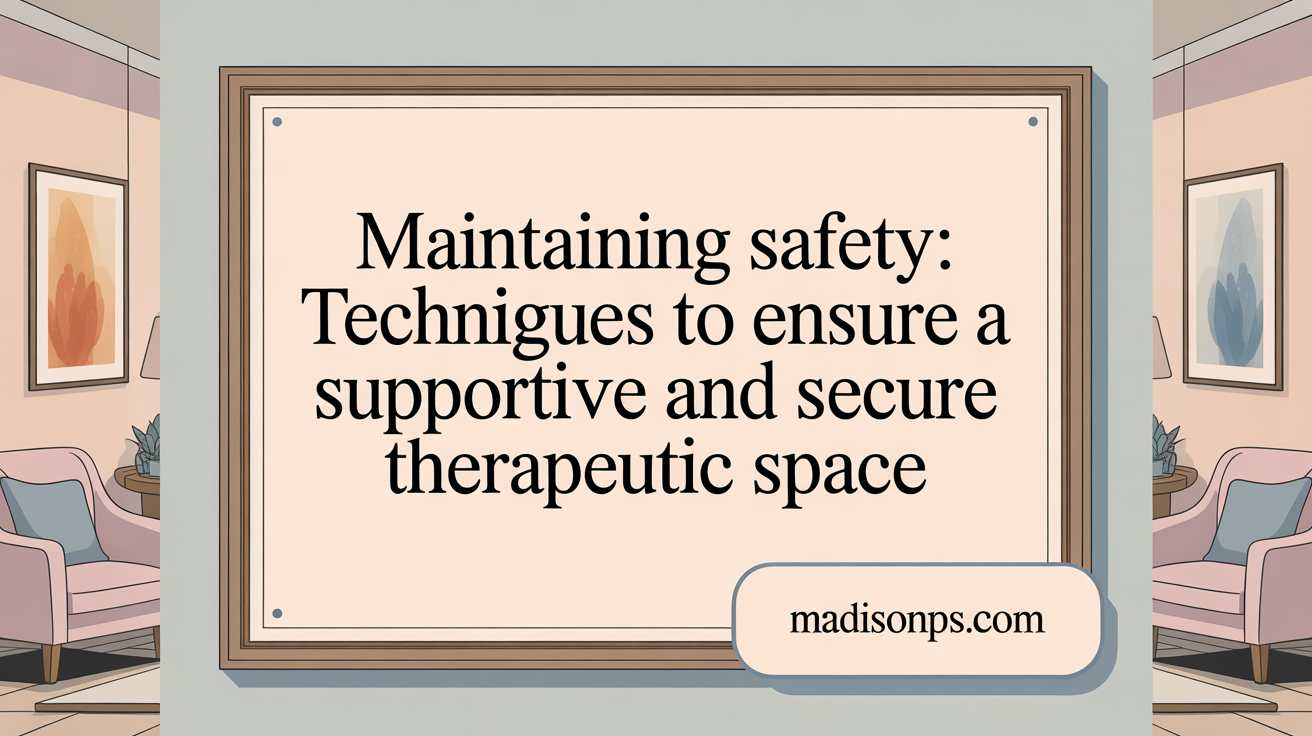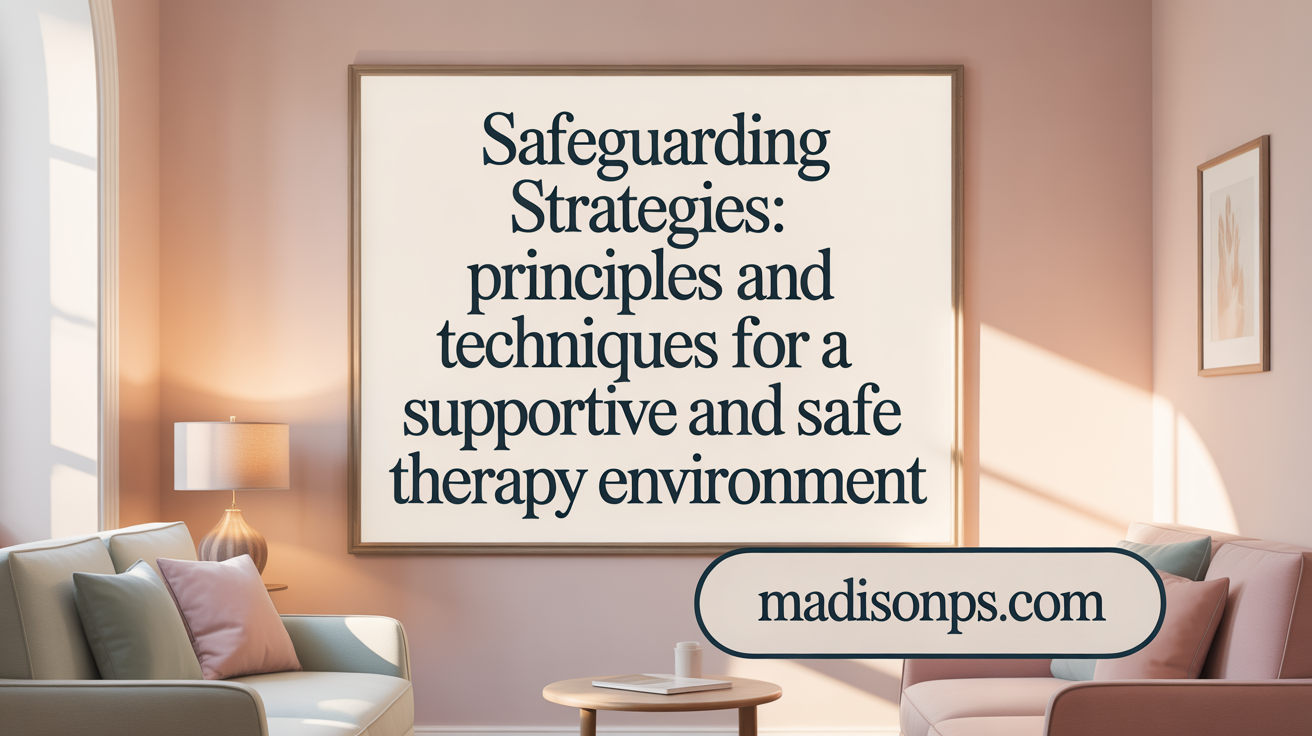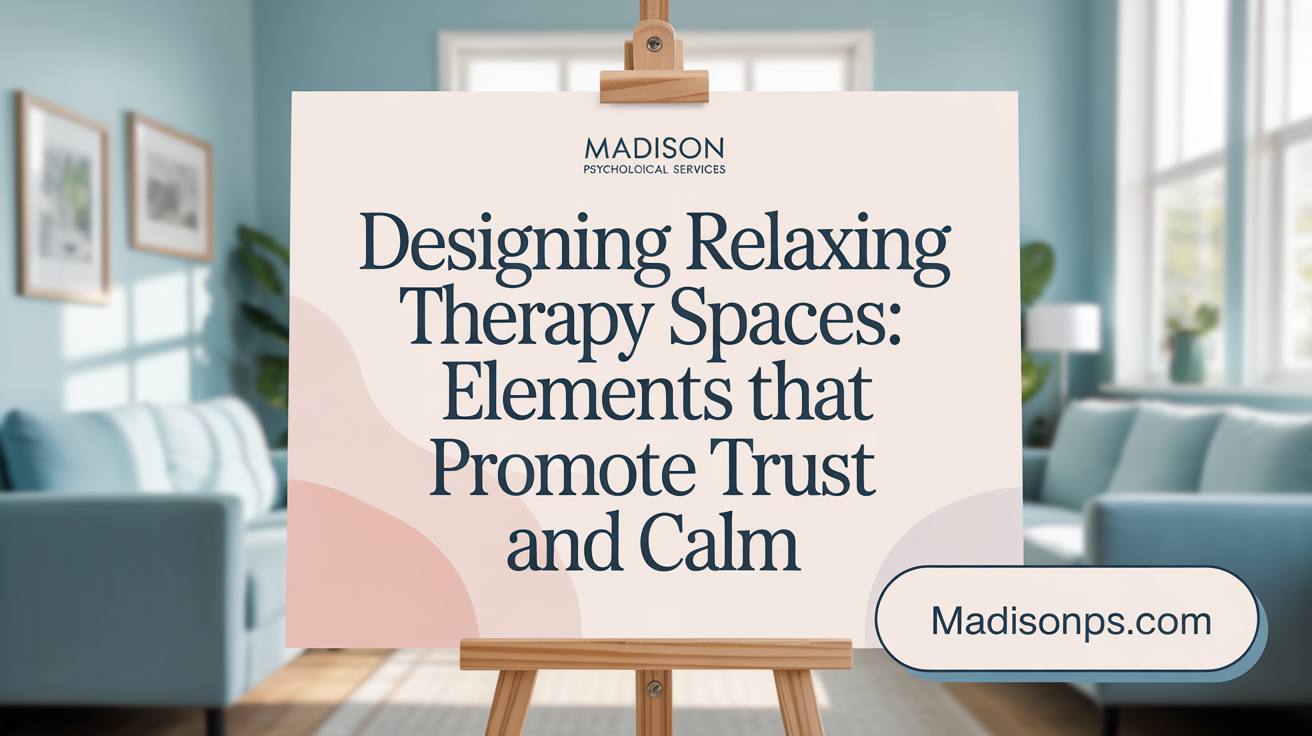Understanding Safety as the Cornerstone of Therapeutic Healing
Safety is fundamental to the healing and growth that occur in psychotherapy. It encompasses a wide range of factors—from physical surroundings to emotional dynamics—that foster trust, openness, and vulnerability. This article delves into what constitutes a safe space in therapy, how therapists cultivate such environments, and why safety plays a pivotal role in healing, especially in trauma recovery. Through an exploration of the therapeutic relationship, environmental design, emotional support, and clinical practices, we uncover how therapy becomes a sanctuary for transformative change.
Defining a Safe Space in Therapy: Beyond the Physical Environment

What does it mean to have a safe space in therapy?
A safe space in therapy is more than just a physical setting; it is an emotional haven where clients feel secure, accepted, and free to openly express their thoughts and feelings. This environment encourages trust and reduces fears of judgment, allowing individuals to explore difficult issues such as trauma, anxiety, or personal challenges without feeling threatened.
Therapists foster safety through various techniques, including safe place imagery and grounding exercises. For example, clients might visualize a peaceful scene—like a beach or forest—that triggers feelings of calm and stability. Grounding methods, such as deep breathing or tactile sensations, help clients manage anxiety and stay present during sessions.
Creating a safe space involves integrating these techniques with different therapeutic approaches, including trauma-focused therapy, cognitive-behavioral therapy, and humanistic methods. This integration ensures that clients not only feel emotionally supported but also are actively engaged in their healing process.
Furthermore, physical and emotional comfort plays a crucial role. Comfortable seating, calming lighting, and a welcoming atmosphere contribute to a sense of safety. Therapists often pay attention to details like noise levels and decor to promote relaxation.
Ultimately, a safe space is vital for facilitating openness, emotional regulation, and resilience. It enables clients to confront difficult topics with confidence, fostering breakthrough moments and lasting change.
How Therapists Cultivate and Maintain Safety During Sessions

How is a safe therapeutic environment created and maintained?
A safe environment in therapy begins with building trust and establishing a strong rapport between the client and therapist. Therapists work to create this sense of safety through empathy, active listening, and demonstrating genuine care. Confidentiality is fundamental; therapists adhere to strict ethical standards to protect client privacy, which reassures clients that their disclosures are secure.
Creating a physically comfortable space also contributes to safety. Soft lighting, calming decor, and a quiet setting help clients feel relaxed and at ease. An environment free from bias, judgment, and threats encourages open communication and honesty.
Flexibility in approach is crucial. Therapists adapt their techniques and pacing based on individual client needs, allowing clients to explore sensitive topics at their own comfort level. This responsiveness demonstrates care and respect, reinforcing the client's confidence in the safety of the process.
Maintaining clear boundaries and adhering to ethical guidelines are essential for reinforcing professionalism and trust. Therapists often discuss confidentiality limits and boundaries upfront, ensuring clients understand and feel secure within therapy.
In summary, creating a safe therapeutic space involves nurturing trust, offering emotional and physical comfort, practicing ethical sensitivity, and remaining adaptable. This holistic approach promotes emotional security, enabling clients to engage deeply in their healing journey and fostering meaningful growth.
Principles and Strategies Therapists Employ to Safeguard Clients

What principles and strategies do therapists use to ensure safety during therapy sessions?
Therapists utilize a multifaceted approach to maintain safety in their clinical practice. Establishing clear boundaries and confidentiality from the outset is fundamental, creating a foundation of trust and predictability that reassures clients and fosters openness.
Screening clients for potential risks such as violence, self-harm, or suicidality is a critical step. This allows therapists to tailor safety plans and intervene early if warning signs appear. Physical safety measures are also implemented, including controlling access to the therapy space, removing objects that may be used to cause harm, and in some cases, installing safety devices like panic buttons or surveillance cameras.
De-escalation techniques are vital tools. Therapists practice active listening, validate emotions, and maintain a calm and neutral demeanor to diffuse tension when conflicts or intense emotions arise. These skills help prevent escalation and ensure a secure environment.
Preparation for emergencies involves developing protocols for various scenarios, knowing the location of emergency contacts, and conducting safety drills with staff when applicable. Being aware of the physical environment and ensuring it supports safety contributes to a trauma-informed setting.
Beyond physical safety, creating emotional safety through empathy and respect is essential. Therapists foster a space where clients feel heard, validated, and free from judgment. This supportive atmosphere encourages honesty and vulnerability, both of which are crucial for effective therapy.
In sum, maintaining safety in therapy combines proactive risk management, physical security measures, emotional support, and preparedness, all aimed at creating a secure environment conducive to healing and growth.
The Impact of the Physical Therapy Environment on Safety and Healing

How does the physical environment impact safety in therapy?
The physical environment plays a crucial role in defining safety within therapy settings. A well-designed space helps establish both emotional and physical security, making clients feel comfortable and protected. Features such as privacy, soundproofing, sufficient natural light, and calming decor contribute to creating an atmosphere conducive to trust and openness.
Natural elements, including plants and scenic artwork, evoke feelings of tranquility and joy, aiding in emotional regulation. Soundproofing minimizes disruptions and external noise, reducing stress and allowing clients to focus inward. Moreover, the layout and material choices influence sensory experiences, helping clients feel grounded and safe.
Creating a space that fosters attachment and reduces anxiety enables clients to relax and engage more deeply in therapy. This sense of containment supports therapeutic aims such as exploration, reflection, and emotional processing.
Overall, a thoughtfully curated environment acts as a foundation for safety, promoting positive affective experiences and nurturing trust between clients and therapists.
Calming decor and natural elements
Incorporating calming decor, such as soft colors, gentle lighting, and natural materials like wood or stone, enhances feelings of safety. These choices create a soothing ambiance that encourages relaxation and openness.
Natural elements like plants, water features, or views of nature can lower stress levels and improve mood. Such features serve as visual cues of safety, helping clients feel more connected to their environment.
Trauma-informed design principles
Trauma-informed design involves physical adjustments that prioritize safety and choice. This might include offering clients options for seating, controlling lighting and noise levels, and avoiding overstimulating or harsh decor.
Minimizing triggers and providing predictable, inviting spaces can prevent re-traumatization and support healing. Including diverse artwork and culturally appropriate symbols fosters inclusivity and respect.
Effects on emotional regulation and trust
A safe, aesthetic environment promotes emotional regulation by reducing sensory overload and stress responses. When clients feel safe physically, they are more likely to trust their therapist and the process.
Trust is further strengthened through consistent, reliable environment cues, which facilitate vulnerability and openness.
Virtual therapy environment considerations
In telehealth settings, visual clarity, privacy, and sound quality are vital for safety. Well-lit, clean backgrounds, and secure connections create an electronic space that fosters trust.
Adapting physical environment principles to virtual settings involves ensuring confidentiality and minimizing distractions, which are essential for effective teletherapy.
Culturally sensitive physical settings
Creating spaces that reflect cultural awareness—through artwork, language, and accessibility options—ensures clients feel valued and respected.
A culturally sensitive setting promotes equality and trust, making clients more comfortable to share their experiences.
| Aspect | Considerations | Impact on Safety and Healing |
|---|---|---|
| Privacy | Soundproofing, private rooms | Prevents external distractions, fosters trust |
| Natural Light | Windows, skylights | Enhances mood, reduces stress |
| Decor | Calm colors, natural elements | Promotes relaxation, emotional comfort |
| Design | Trauma-informed choices | Avoids triggers, supports healing |
| Virtual Spaces | Secure connections, clear visuals | Builds confidence in online therapy |
| Cultural Elements | Inclusive artwork, language | Increases sense of belonging |
Enhancing the physical space in these ways nurtures an environment where clients feel safe, supported, and encouraged to pursue emotional growth and resilience. By paying attention to these details, therapists create not only a functional space but also a sanctuary for healing.
Emotional Safety: The Heart of Therapeutic Healing
What role does emotional safety play in the therapy and healing process?
Emotional safety is fundamental for effective psychotherapy and recovery. It involves creating a space where clients feel genuinely accepted, understood, and free to share their deepest thoughts and feelings without fear of judgment or rejection. This sense of security helps build trust between the client and therapist, which is essential for a strong therapeutic bond.
Creating emotional safety also supports nervous system regulation, especially crucial in trauma recovery. When clients feel safe, their bodies can shift from states of hypervigilance or shutdown to a calmer, more social engagement mode—facilitated by the ventral vagal state described in polyvagal theory. This calming effect allows clients to lower defenses, process traumatic memories more effectively, and develop new coping strategies.
Vulnerability naturally emerges within a safe environment. As clients feel secure, they become more willing to explore difficult experiences and emotions. Such openness fosters self-awareness and integration of different parts of their personality, facilitating growth and healing.
In addition, emotional safety underpins the therapeutic alliance—an influential predictor of treatment success. When clients trust that the therapist will respect boundaries and maintain confidentiality, they are more likely to engage fully and honestly in therapy sessions.
Ultimately, emotional safety acts as a foundation for healing, resilience, and personal development. It enables individuals to confront past wounds, develop inner resources like self-compassion, and achieve meaningful change for a healthier, more connected life.
More about emotional safety
Research highlights that fostering emotional safety in therapy correlates with better outcomes, increased engagement, and deeper emotional work. Creating this environment involves empathy, active listening, respectful boundaries, and cultural sensitivity, all designed to support clients’ unique needs and backgrounds.
Creating a space of emotional safety isn’t static—it requires ongoing attention and adjustment throughout therapy. Whether in person or virtual settings, ensuring clients feel secure promotes openness, fosters vulnerability, and ultimately paves the way for transformative healing.
Safety’s Central Role in Trauma Therapy and Recovery
What is the role of safety in trauma therapy and recovery?
Safety is fundamental in trauma therapy and recovery because it creates a foundation where clients feel protected, supported, and able to explore difficult emotions and memories. When clients perceive their environment—both physical and emotional—as safe, they are more likely to lower defenses, regulate their nervous systems, and confront their trauma without re-experiencing distress or retraumatization.
In trauma-informed care, safety involves not only physical comfort but also emotional trust, confidentiality, and cultural sensitivity. Establishing clear boundaries and consistent support helps clients develop internal resources like mindfulness, grounding, and body awareness, which serve as tools for self-regulation.
Trauma impacts the nervous system, often leading to hypervigilance or shutdown responses. Creating a safe therapeutic environment helps shift the nervous system back to ventral vagal state—the safety and social engagement state per polyvagal theory. This shift enables clients to process trauma more effectively, reducing symptoms like dissociation or hyperarousal.
Furthermore, safety supports the therapeutic alliance, a collaborative relationship built on trust, empathy, and respect. Therapists can foster safety through active listening, validation, non-judgmental presence, and maintaining boundaries. This environment encourages openness, honesty, and vulnerability, which are crucial for trauma healing.
Without safety, clients are unlikely to access the deep emotional work necessary for resolution. Conversely, a secure setting allows trauma survivors to revisit painful experiences in manageable doses, integrate new insights, and rebuild a sense of control and resilience. Therefore, safety in trauma therapy is not just supportive—it is essential for transformation and lasting recovery.
How safety relates to grounding and self-regulation techniques
Grounding and self-regulation are practical methods enabled by a safe environment. Techniques such as deep breathing, visualization, mindfulness, or body scans help clients stay present and calm their nervous system.
Therapists often teach these skills explicitly, knowing that when clients feel safe, they are more receptive and able to use them effectively. These strategies reduce anxiety, diminish dissociation, and maintain the client's presence during difficult discussions.
How nervous system states and polyvagal theory inform safety
Polyvagal theory describes three autonomic nervous system states: ventral vagal (safety and social connection), sympathetic (fight or flight), and dorsal vagal (shutdown or immobilization). Trauma can cause clients to remain stuck in sympathetic or dorsal vagal states, impeding recovery.
Creating safety helps clients shift back to ventral vagal, where feelings of calm, engagement, and openness are possible. This transition is facilitated by supportive relationships, calming environments, and body-based techniques, all aimed at rebooting the body's innate safety mechanisms.
How building trust is essential in trauma-sensitive care
Trust is the cornerstone of trauma-informed therapy. It is built through consistent, respectful interactions characterized by empathy, validation, and authenticity. When clients trust their therapist, they are more willing to explore vulnerability, share traumatic memories, and engage deeply in the healing process.
Establishing trust also reduces feelings of shame and isolation, which are common in trauma survivors. Clear communication about boundaries, confidentiality, and pacing reassures clients that their safety comes first.
How safe therapeutic relationships support trauma recovery
Strong, safe relationships in therapy foster emotional security, making it easier for clients to confront and work through trauma. When clients feel genuinely valued and understood, they can relax and access their innate healing capabilities.
Therapists’ genuine care, active listening, and culturally sensitive practices reinforce safety, creating an environment where trust and vulnerability thrive. This nurturing space allows trauma survivors to reconnect with themselves and others, promoting resilience and growth.
The Therapeutic Relationship: Foundation of Trust and Transformation

What is a therapeutic relationship and why is it important in therapy?
A therapeutic relationship is a professional bond of trust and rapport between a healthcare provider and a client. Its purpose is to support the client in achieving personal growth, healing, and fulfilling their therapeutic goals.
This relationship creates a safe space where clients feel comfortable expressing their thoughts, fears, and vulnerabilities. Such openness is crucial for meaningful progress in therapy.
The strength of this bond relies on essential qualities like empathy, confidentiality, and professionalism. Empathy allows clients to feel understood and validated, making therapy more effective.
Maintaining strict confidentiality reassures clients that their personal information and feelings are protected, fostering trust. Professional boundaries and ethical guidelines ensure the relationship remains safe and respectful.
Collaboration and mutual understanding are also vital. Therapists and clients work together towards shared goals, with the therapist guiding and supporting the client’s journey.
A positive therapeutic alliance enhances client engagement, improves adherence to treatment, and leads to better outcomes. Such a relationship empowers clients to explore difficult issues and make significant changes.
Cultural competence further enriches this bond. Recognizing and respecting clients’ backgrounds and values helps build a truly inclusive and effective therapeutic space.
Overall, a strong, trusting therapeutic relationship is the cornerstone of successful therapy, providing the emotional support needed for healing and personal development.
Safety as the Foundation for Healing and Growth in Therapy
Safety in therapy is not simply the absence of harm but the presence of an empowering, supportive environment that nurtures trust, vulnerability, and exploration. It is a multifaceted concept, encompassing physical, emotional, relational, and cultural dimensions, all of which intertwine to create a sanctuary for healing. By cultivating safe spaces through thoughtful environmental design, ethical clinical practices, and empathetic therapeutic relationships, therapy facilitates profound personal transformation and resilience. Recognizing and prioritizing safety enables clients to engage deeply, confront vulnerabilities, and ultimately experience meaningful healing and lasting change.
References
- The Functions of Safety in Psychotherapy: An Integrative Theoretical ...
- The Heart of Therapy: Creating a Safe Space for Individual Clients
- Creating a Safe and Comforting Environment for Therapy
- The Importance of Feeling Safe In Trauma Therapy - Khiron Clinics
- Psychotherapy and Therapeutic Relationship - StatPearls - NCBI
- Safe Space Counseling: Building Your Mental Health Therapy On ...
- Creating Safe Spaces: The Importance of Supportive Counseling ...
- The Importance of Safe Spaces for Healing Trauma
- Creating a Safe Space for Healing - The Wellness Station
- How Your Therapy Session Room Impacts Safety, Connection, and ...
